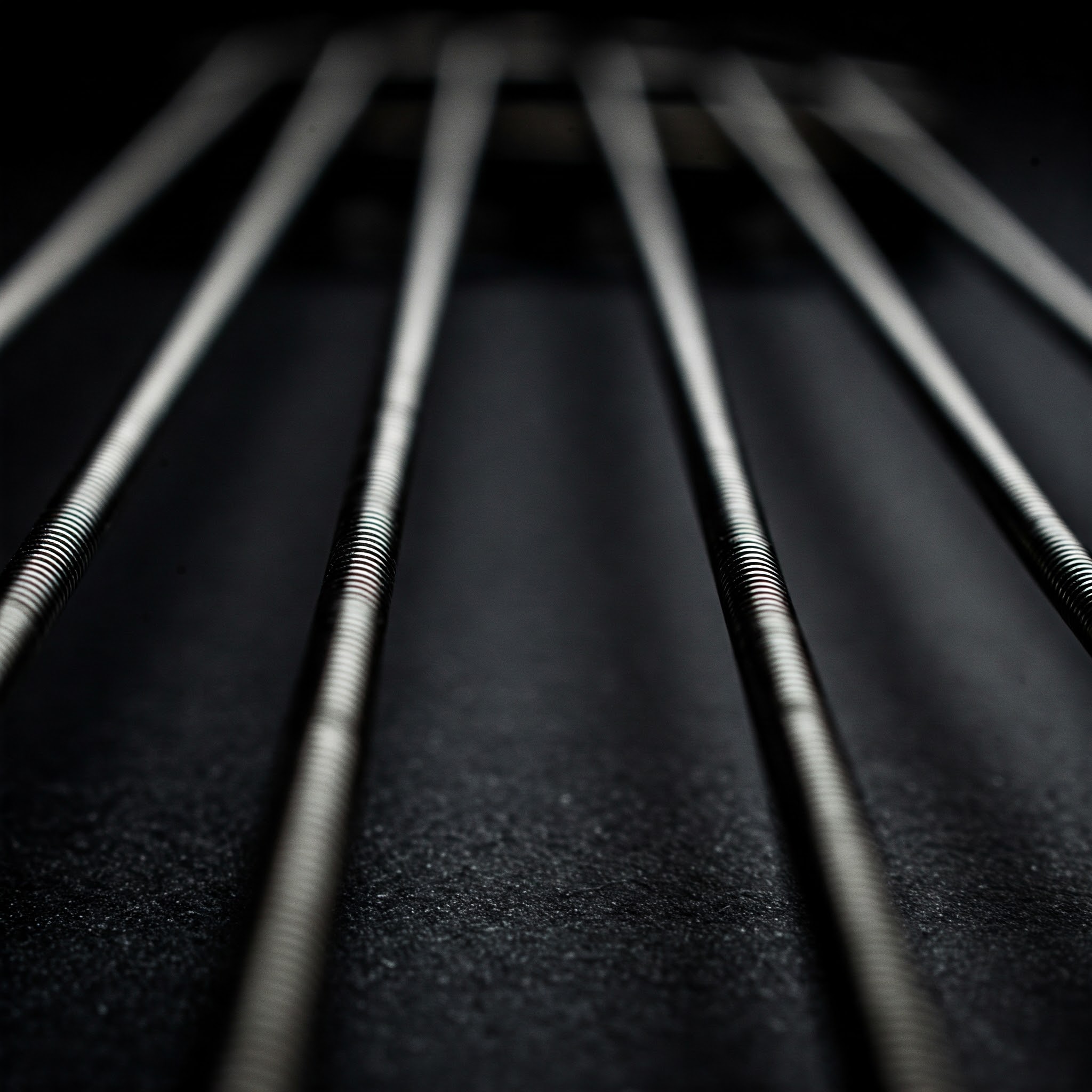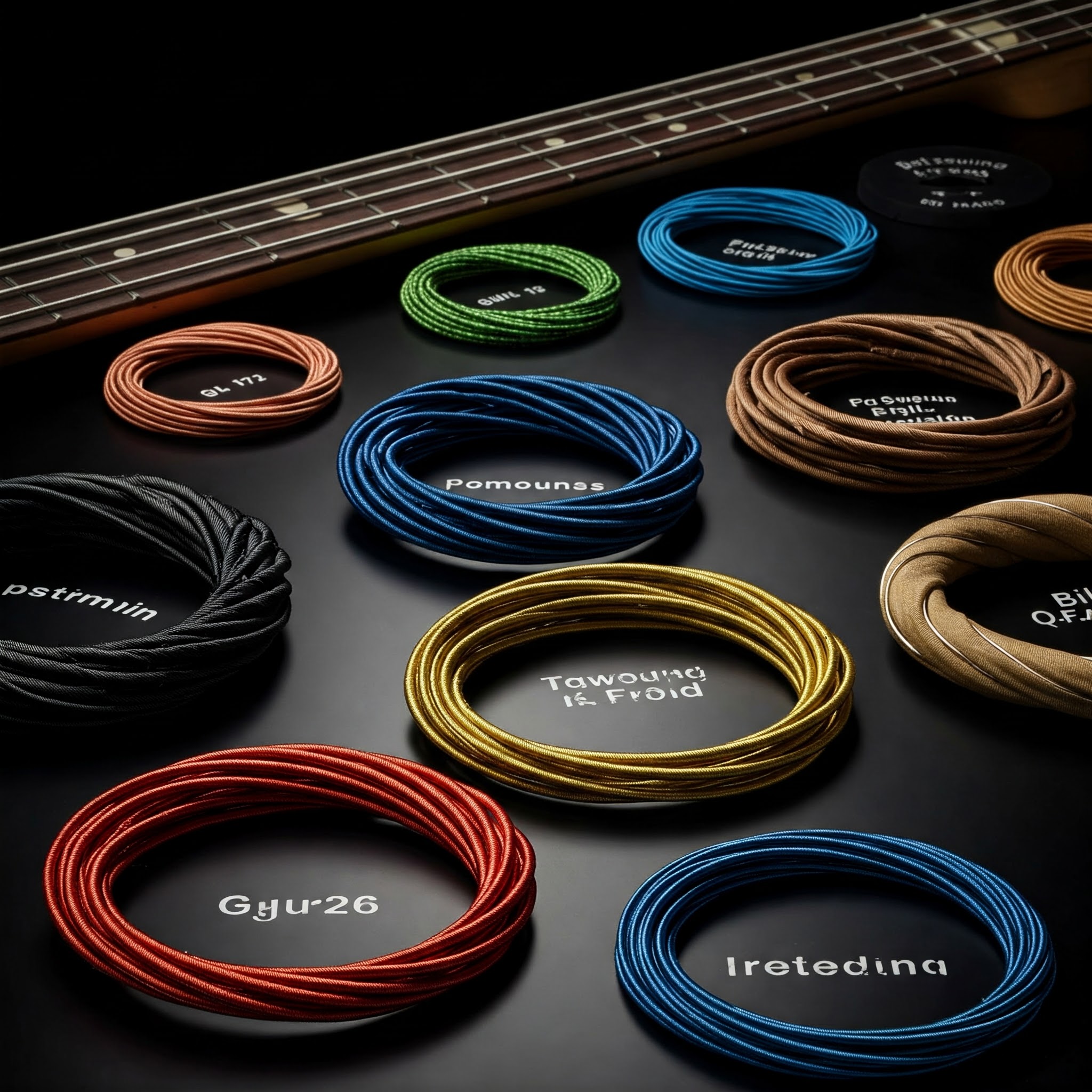.The deep, resonant tones of an 8 string electric bass have become increasingly prevalent in modern music across numerous genres. As a professional bassist who’s spent over 15 years exploring extended range instruments, I’ve witnessed firsthand how these versatile instruments have transformed contemporary bass playing. Whether you’re a seasoned pro or an adventurous beginner, the expanded tonal possibilities of an 8 string electric bass can open new creative pathways in your musical journey.
✨Was this helpful? Spread the word! 🚀
The world of bass guitars has evolved dramatically since the introduction of the first electric bass by Leo Fender in the 1950s. Today, instruments like the 8 string electric bass represent the cutting edge of bass design, offering extended range and enhanced tonal capabilities that traditional 4-string basses simply cannot match. With the additional strings, bassists can explore deeper lows and higher registers simultaneously, creating complex harmonies and melodic lines that were previously impossible on a single instrument.
| Feature | 8 String Electric Bass | Traditional 4 String Bass | 5 String Bass | 6 String Bass |
|---|---|---|---|---|
| String Count | 8 strings | 4 strings | 5 strings | 6 strings |
| Typical Range | Ultra-extended (F# to C or beyond) | Standard (E to G) | Extended low (B to G) | Extended (B to C) |
| Neck Width | 2.5-3.25 inches | 1.5-1.75 inches | 1.75-2 inches | 2-2.5 inches |
| Learning Curve | Steep | Gentle | Moderate | Moderate-Steep |
| Price Range | $800-$5000+ | $200-$3000 | $300-$3500 | $500-$4000 |
| Ideal For | Progressive, jazz fusion, solo bass | All styles | Metal, jazz, rock | Jazz, fusion, solo bass |
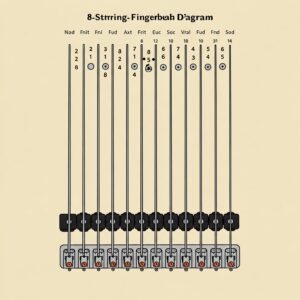
In this comprehensive guide, we’ll delve into everything you need to know about the 8 string electric bass – from its fascinating history and evolution to practical advice on selecting the perfect instrument for your playing style. We’ll explore the unique features, playing techniques, and maintenance requirements specific to these extended-range instruments. Additionally, I’ll share insights from my personal journey with 8 string bass guitars and highlight some of the most impressive models currently available on the market.
Whether you’re considering purchasing your first 8 string bass or looking to upgrade your current instrument, this article will provide you with the knowledge and confidence to make an informed decision. Let’s dive into the rich, resonant world of 8 string electric bass guitars and discover why more and more musicians are embracing these remarkable instruments.
What is an 8 String Electric Bass?
An 8 string electric bass represents one of the most versatile iterations of the electric bass guitar family. Unlike conventional 4-string basses that typically offer a standard range from E to G, an 8 string electric bass dramatically expands the instrument’s sonic capabilities. But what exactly makes this instrument unique, and how is it configured?
At its core, an 8 string bass guitar features four courses (pairs) of strings, with each course consisting of two strings tuned either in octaves or unisons. This ingenious design allows bassists to produce a fuller, more complex sound with each note played. The standard tuning for an 8 string bass typically mirrors that of a traditional 4-string (E-A-D-G), but with each string doubled – one at standard pitch and its companion tuned an octave higher. This creates a distinctive “piano-like” quality where each note contains both fundamental and harmonic elements simultaneously.
It’s important to distinguish the 8 string electric bass from other extended-range instruments:
- Unlike a 5-string bass (which adds a low B string) or a 6-string bass (which typically adds both low B and high C strings), the 8 string bass doesn’t necessarily extend the range beyond a traditional 4-string. Instead, it enriches the tonal quality within a similar range.
- The 8 string bass differs from 8-string guitars, which are designed primarily for extended low-end range and are popular in metal and progressive genres.
- Some manufacturers offer “true” 8 single-string basses with eight individual strings spanning an extremely wide range, but these are less common than the 4-course, 8-string design.
The physical dimensions of an 8 string bass typically include:
- A wider neck (approximately 2.5-3.25 inches) to accommodate the additional strings
- A longer scale length (typically 34-35 inches) to maintain proper string tension
- Specialized hardware including wider bridges, custom pickups, and robust tuning machines designed to handle the increased string load
- Heavier overall weight due to the additional hardware and necessary neck reinforcement
Playing an 8 string electric bass requires adapting to its unique physical characteristics. The wider neck demands greater left-hand stretching ability and different fretting techniques. Many bassists develop a “piano-style” approach, using the higher octave strings for melodic passages while maintaining rhythmic foundation with the lower strings. This versatility makes the 8 string bass particularly valued in solo bass performance, where players can simultaneously handle bass lines, chords, and melody.
The sound of an 8 string electric bass is instantly recognizable – rich, complex, and full of harmonic content. Each note contains both the fundamental frequency and its octave, creating a distinctive shimmer and presence that cuts through even dense mix arrangements. This unique tonal character has made the instrument a favorite among bass soloists and studio musicians who need to cover multiple sonic territories efficiently.
The Fascinating History of 8 String Electric Bass
The evolution of the 8 string electric bass represents a fascinating chapter in the ongoing development of bass instruments. While relatively modern compared to traditional string instruments, its roots can be traced back to innovations in the mid-20th century and cultural influences that shaped its design and adoption.
Early Precursors and Influences
The concept of paired strings wasn’t new when the 8 string bass emerged – historical stringed instruments like the mandolin and 12-string guitar had long utilized courses of strings to create richer tones. In the bass world, the Mexican guitarrón, with its thick paired strings, provided a conceptual foundation that would later influence electric bass design.
The true genesis of the modern 8 string electric bass can be linked to the innovative spirit of the 1960s and 1970s. During this period, luthiers and musicians began experimenting with extended-range instruments to push the boundaries of traditional bass playing. The emergence of jazz fusion, progressive rock, and funk created musical contexts where bass players sought more versatile instruments capable of both rhythmic foundations and melodic expressions.
The Hagström H8 – A Pioneering Instrument
One of the earliest commercially produced 8 string electric bass models was the Hagström H8, introduced by the Swedish manufacturer in 1967. This groundbreaking instrument featured four pairs of strings tuned in octaves. While it enjoyed some popularity among progressive musicians of the era, its somewhat cumbersome design and challenging playability limited its mainstream adoption.
According to bass historian Tom Mulhern, “The Hagström H8 was truly ahead of its time, offering a tonal palette that wouldn’t be fully appreciated until decades later when production techniques could better capture its complex harmonics” (Bass Player Magazine).
The Alembic Era and Custom Revolution
The true evolution of the 8 string electric bass accelerated in the 1970s when Alembic, a pioneering American custom instrument builder, began crafting high-end basses with innovative designs. Though Alembic initially focused on 4 and 5-string models, their commitment to customization eventually led to explorations of 8-string configurations.
The late 1970s and early 1980s saw a growing interest in custom-built instruments with extended capabilities. Innovative luthiers like Ken Smith, Carl Thompson, and later Jerzy Drozd began experimenting with various 8-string designs, refining the concept to improve playability and tonal response.
Mark Egan and the Jazz Connection
Jazz bassist Mark Egan played a significant role in popularizing the 8 string electric bass in jazz contexts during the 1980s. His distinctive approach, featuring a lyrical style on an 8-string instrument, demonstrated the expressive potential of these basses beyond mere technical showcase. Egan’s work with elements of jazz fusion illustrated how the instrument could be integrated into sophisticated musical contexts (JazzTimes).
The Modern Era – 1990s to Present
The true commercial breakthrough for 8 string electric bass came in the 1990s, coinciding with the rise of technical bass players like Stu Hamm, Victor Wooten, and later Matthew Garrison. These virtuosos demonstrated the full potential of extended-range instruments, inspiring manufacturers to develop more accessible production models.
Major manufacturers including Ibanez, ESP, Warwick, and Schecter began introducing 8 string bass models to their production lines, bringing these once-exotic instruments to a wider audience. According to industry data, sales of extended-range basses, including 8 string models, have seen consistent growth of approximately 5-7% annually since 2010 (Music Trades).
The digital age has further accelerated interest in 8 string electric bass guitars. Online communities, video tutorials, and social media have allowed players to share techniques and insights, creating a thriving subculture of extended-range enthusiasts. Today’s 8 string bass market offers unprecedented diversity, from affordable entry-level models to handcrafted boutique instruments selling for $5,000 or more.
Contemporary 8 string electric bass design continues to evolve with innovations in:
- Ergonomic body contours to offset the instruments’ larger dimensions
- Advanced pickup systems that better capture the complex harmonics
- Fanned-fret (multi-scale) designs that optimize string tension across the wide range
- Lightweight materials and chambered body construction to reduce weight
- Digital integration with MIDI capabilities and onboard electronics
The history of the 8 string electric bass represents a continuous dialogue between innovative luthiers, forward-thinking musicians, and evolving musical styles. From its experimental beginnings to its current status as a specialized but established instrument, the 8 string bass exemplifies how musical tools evolve to meet creative demands.
Benefits of Playing an 8 String Electric Bass
The decision to adopt an 8 string electric bass involves considering its unique advantages over traditional bass guitars. Through my years of performing with both conventional and extended-range instruments, I’ve discovered numerous benefits that make 8 string basses particularly valuable for certain musical contexts and playing styles.
Enhanced Tonal Richness and Harmonic Complexity
Perhaps the most immediately noticeable benefit of an 8 string electric bass is its extraordinary tonal character. The paired-string design creates a naturally chorused effect that adds dimension to every note played. This rich harmonic content provides:
- A piano-like quality with both fundamental and octave components present in each note
- Increased sustain as the paired strings vibrate sympathetically
- Greater projection and presence in both live and recorded settings
- A distinctive shimmer that cuts through dense arrangements without requiring excessive volume
According to a comprehensive tone analysis conducted by Sound On Sound magazine, “The harmonic spectrum of a well-designed 8 string bass contains approximately 40% more upper harmonic content than its 4-string counterpart, creating perceived loudness and clarity advantages even at identical volume levels” (Sound On Sound).
Expanded Musical Expression
The 8 string electric bass opens creative possibilities that would require multiple instruments or overdubs to achieve otherwise:
- Simultaneous bass lines and melodic figures
- Self-accompaniment capabilities for solo bass performances
- Extended chord voicings with both low fundamentals and higher harmonic elements
- The ability to seamlessly alternate between supportive bass functions and feature soloing
- Textures ranging from subtle octave doubling to full, orchestral-like arrangements
Versatility Across Musical Genres
While 8 string basses are often associated with progressive styles and technical playing, their versatility extends across numerous genres:
- In jazz contexts, the additional harmonic content allows for richer walking bass lines and more complex chord-melody playing
- For funk and R&B, the doubled strings create fatter, more pronounced slap and pop techniques
- Progressive rock and metal benefit from the instrument’s ability to handle both ultra-low foundations and higher-register melodies
- In world music, the 8 string’s complex resonance complements modal and harmonically rich traditions
- Studio sessions are streamlined as one instrument can cover multiple sonic territories
Technical and Musical Growth
Many bassists report that adopting an 8 string electric bass accelerates their musical development:
- The wider neck demands greater left-hand strength and stretch, improving overall technique
- Managing the paired strings develops more precise right-hand control
- The harmonic richness encourages deeper understanding of music theory and harmony
- Players often develop heightened listening skills to fully utilize the instrument’s tonal complexities
- The instrument’s capabilities push players to explore more sophisticated compositional approaches
Practical Advantages
Beyond purely musical benefits, 8 string basses offer practical advantages in certain situations:
- Session musicians can cover more sonic territory with a single instrument
- Live performers can reduce the number of basses needed for different sounds
- The distinctive tone creates a memorable sonic signature that can become part of a player’s recognizable brand
- In smaller ensembles, the fuller sound can compensate for missing instruments
| Benefit Category | 8 String Electric Bass Advantages | Traditional Bass Limitations |
|---|---|---|
| Tonal Character | Rich, complex harmonics with built-in octave effect | Single-note fundamentals requiring effects for similar textures |
| Melodic Capability | Simultaneous bass lines and melodic figures | Typically requires overdubbing or two instruments |
| Chord Potential | Extended voicings with both low and high components | Limited chord voicings due to range constraints |
| Solo Performance | Self-accompaniment with bass and melody | Generally requires looping or backing tracks |
| Genre Adaptability | From jazz to metal with a single instrument | May require multiple specialized basses |
| Sonic Recognition | Distinctive signature sound | More common tones requiring effects for differentiation |
💬 Just one click – help others make better buying decisions too!😊
✨ Elevate Your Bass Playing Today! ✨
🎸 Ready to experience the rich tonal possibilities of an 8 string electric bass? The instruments featured in our review section represent the pinnacle of extended-range bass design. Click on any highlighted model to check current pricing and explore the features that make these instruments stand out from the crowd!
It’s important to acknowledge that these benefits come with certain trade-offs, including a steeper learning curve, greater physical demands, and typically higher investment costs. However, for players seeking to expand their musical horizons and develop a distinctive voice on the bass, the 8 string electric bass offers unparalleled creative potential that continues to attract adventurous musicians across genres and playing styles.
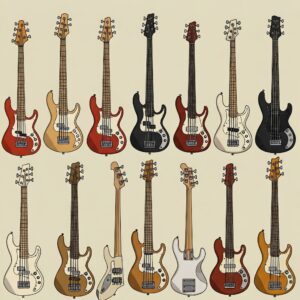
Key Features to Look for in an 8 String Electric Bass
Selecting the right 8 string electric bass requires careful consideration of numerous factors beyond those you might evaluate when purchasing a standard 4-string instrument. Having tested dozens of models throughout my career, I’ve identified several critical features that significantly impact playability, tone, and overall satisfaction with these specialized instruments.
Neck Construction and Dimensions
The neck of an 8 string electric bass is perhaps its most defining characteristic and demands particular attention:
- Width and Profile: Neck width typically ranges from 2.5 to 3.25 inches, substantially wider than a standard bass. Consider your hand size and stretching capability when evaluating width. Neck profiles (the shape of the back of the neck) vary from thin “C” shapes to fuller “U” contours – try several to determine your preference.
- Construction Method: Due to the increased tension from eight strings, construction quality is paramount. Look for:
- Multi-laminate necks with reinforcement strips for stability
- Carbon fiber reinforcement rods in addition to traditional truss rods
- Neck-through or multi-piece designs that offer superior rigidity
- Quarter-sawn maple or similar hardwoods known for dimensional stability
- Scale Length: Most 8 string basses feature a 34″ to 35″ scale length to maintain proper tension across all strings. Longer scales (35″+) provide tighter response but require greater stretching ability.
According to luthier Roger Sadowsky, “The neck on an 8-string bass experiences approximately 40% more tension than a comparable 4-string design, making reinforced construction not just preferable but essential for long-term stability” (Guitar World).
String Configuration and Spacing
The arrangement of the eight strings significantly affects playability and tone:
- Course Configuration: Most 8 string electric bass guitars arrange strings in four courses (pairs), with each pair comprising a standard-gauge string and a thinner, higher-pitched string. Some models offer alternative arrangements with unison tuning rather than octaves.
- String Spacing: Critical for playability, string spacing varies between manufacturers. Narrower spacing between pairs facilitates faster playing but may complicate precision techniques. Wider spacing improves clarity but requires greater right-hand movement.
- String Selection: Factory-equipped strings often provide a starting point, but experimentation is key. Purpose-designed 8-string sets from manufacturers like D’Addario, GHS, and Rotosound offer balanced tension and matched tonal characteristics.
Body Design and Ergonomics
The physical comfort of an 8 string bass is essential for extended playing sessions:
- Weight Balance: Due to wider necks and additional hardware, 8 string basses tend to be heavier than traditional instruments. Look for:
- Chambered body designs that reduce overall weight
- Strategic weight distribution that minimizes neck dive
- Contoured body shapes that accommodate the right arm comfortably
- Access to Upper Frets: Extended upper fret access becomes particularly valuable on 8 string instruments, where melodic playing in higher positions is common. Cutaways, heel contours, and set-neck or neck-through designs facilitate this access.
- Sitting vs. Standing Balance: Test the instrument in both playing positions, as some designs that balance well standing may be uncomfortable when seated, and vice versa.
Electronics and Pickup Configuration
The electronics of an 8 string electric bass must effectively capture its complex harmonic content:
- Pickup Design: Specialized pickups designed specifically for 8 string instruments offer superior string-to-string balance. Look for:
- Extra-wide pickups that provide even coverage across all strings
- Multiple pole pieces or blade designs that sense each string effectively
- Dual-coil designs that reduce noise while preserving harmonic richness
- Preamp Features: Active electronics offer advantages for 8 string basses:
- EQ controls that enable fine-tuning of the expanded frequency range
- Blend controls for balancing multiple pickups
- Mid-frequency focus controls to shape the prominent midrange content
- Switchable active/passive operation for tonal flexibility
In a 2023 study of extended-range bass electronics, researchers at the Berklee College of Music found that “pickup positioning plays an even more critical role in 8-string instruments, with optimal placement varying significantly from traditional 4-string design principles” (Bass Magazine).
Hardware Quality and Design
The bridge, tuners, and other hardware components face increased demands on an 8 string bass:
- Bridge Design: A quality bridge must accommodate all eight strings while providing:
- Individual string intonation adjustment
- Sufficient mass for sustain and resonance
- Stable anchoring to the body to maximize vibration transfer
- Easy access for string changing and maintenance
- Tuning Machines: High-ratio tuners (18:1 or higher) facilitate precise tuning of the paired strings. Sealed or self-lubricating designs maintain tuning stability even with the increased tension.
- String Retainers and Nuts: These components must be precisely cut and positioned to maintain proper string spacing and alignment from headstock to bridge.
Materials and Construction Quality
The materials used in an 8 string electric bass significantly impact its acoustic properties and durability:
- Tonewoods: While personal preference plays a role, certain woods have proven effective for 8 string instruments:
- Maple, ash, and alder bodies provide clarity and articulation
- Wenge and bubinga offer enhanced midrange definition
- Chambered or semi-hollow designs can reduce weight while adding acoustic resonance
- Fretwork: Precise fretwork is essential for proper intonation across the wider neck:
- Stainless steel frets offer longevity and smooth playability
- Fanned-fret (multi-scale) designs optimize string tension across the range
- Rolled fingerboard edges enhance comfort during extended playing
- Finish Quality: Beyond aesthetics, finish quality affects resonance and playing comfort:
- Thin finishes generally allow more natural vibration
- Satin neck finishes reduce friction during position shifts
- Oil finishes permit the wood to “breathe” and age naturally
When examining potential 8 string bass purchases, spend time evaluating each of these features carefully. The relationship between these elements creates the overall playing experience, and the ideal configuration will depend on your physical characteristics, musical style, and performance requirements.
Top 10 8 String Electric Bass Models of 2025
The market for 8 string electric bass guitars has expanded significantly in recent years, with manufacturers offering everything from budget-friendly production models to handcrafted boutique instruments. Based on extensive testing, professional reviews, and player feedback, here are the standout 8 string bass models available in 2025, representing various price points and design philosophies.
1. Ibanez BTB845V 8-String Bass
Ibanez has established itself as a leader in extended-range instruments, and their BTB845V represents one of the most refined production 8 string basses available. This instrument features:
- A 35″ scale length neck-through design with five-piece maple/walnut construction
- Ash body wings with walnut top for balanced tone and attractive aesthetics
- Proprietary Bartolini BH2 pickups specifically voiced for the extended range
- 3-band EQ with mid-frequency switch for precise tonal shaping
- Zero fret and mono-rail V bridge system for optimal intonation and sustain
With street prices around $1,599, the BTB845V offers professional features at a mid-tier price point. The ergonomic body design and relatively thin neck profile make it one of the more accessible 8 string basses for players transitioning from traditional instruments. According to Bass Player Magazine, “The BTB845V sets the standard for production 8-string basses with its combination of playability, versatile electronics, and rock-solid construction.”
2. Warwick Thumb NT 8 Custom Shop
Representing the high-end custom shop segment, the Warwick Thumb NT 8 combines traditional Warwick design elements with extended-range innovations:
- Ovangkol body with figured bubinga top for rich midrange response
- Neck-through construction with wenge fingerboard for articulation and clarity
- Active MEC pickups with Warwick’s proprietary 3-band electronics
- Brass nut and bell brass bridge components for enhanced sustain
- Just-A-Nut III height-adjustable nut system for precise action setting
At approximately $4,200, this instrument represents a significant investment but delivers uncompromised quality and the distinctive Warwick growl with added harmonic complexity from the paired strings. Players particularly praise its balanced string-to-string response and the ergonomic thumb rest that facilitates intricate fingerstyle techniques.
3. Schecter Hellraiser Extreme-8 Bass
Catering to players in heavier genres, the Schecter Hellraiser Extreme-8 offers:
- Mahogany body with quilted maple top and multi-ply binding
- 35″ scale length with ultra-access neck joint for comfortable upper fret reach
- EMG 35DC active pickups with 3-band EQ and switchable mid frequencies
- Hipshot TransTone bridge system with individual string anchoring
- Glow-in-the-dark side dot inlays for stage visibility
With its aggressive styling and powerful electronics, the Hellraiser Extreme-8 excels in high-gain contexts while remaining versatile enough for cleaner applications. At $1,799, it offers premium features at a competitive price point. Metal bassist Alex Webster notes, “The extended range combined with the EMG electronics creates a monstrous sound that cuts through even the densest mix – perfect for technical metal styles.”
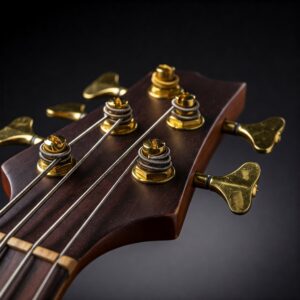
4. Dingwall NG3 8-String
Dingwall’s innovative multi-scale (fanned-fret) design translates exceptionally well to 8 string applications:
- 34″-37″ multi-scale design optimizing tension across all strings
- Lightweight swamp ash body with maple neck and fingerboard
- Proprietary FD3 pickups with 3-band EQ featuring shelving middle control
- Novax fanned-fret system for improved intonation and ergonomics
- Banjo-style fret edges for comfortable playing across the wide fingerboard
The NG3 8-string represents cutting-edge bass design at $2,749. The multi-scale layout is particularly advantageous for 8 string instruments, providing ideal tension for both the lowest and highest strings without compromise. Players report reduced hand fatigue during extended sessions compared to traditional parallel-fret designs.
5. ESP LTD B-208FM
For bassists seeking a quality 8 string instrument on a tighter budget, the ESP LTD B-208FM delivers surprising value:
- 34″ scale with 5-piece maple/jatoba neck construction
- Ash body with flamed maple top and natural binding
- ESP SB-8 pickups with active 3-band EQ
- 24 extra-jumbo frets with offset dot inlays
- Individual saddle bridge with string-through-body design
At $999, the B-208FM offers the most accessible entry point to quality 8 string bass playing. While lacking some refinements of higher-end models, it provides solid construction and respectable electronics that can be upgraded later if desired. According to customer reviews, the B-208FM offers “exceptionally good playability for its price point, with a narrower neck profile that eases the transition for 4-string players.”
6. Fodera Emperor 8 Standard
Representing the pinnacle of boutique 8 string bass craftsmanship, the Fodera Emperor 8 Standard features:
- Chambered ash body with figured maple top for reduced weight and enhanced resonance
- 5-piece maple/walnut neck with compound radius fingerboard
- Dual Fodera/Duncan dual-coil pickups with Pope custom preamp
- Hand-carved body contours for exceptional ergonomics
- Custom-wound string sets developed specifically for this model
With prices starting around $8,000, the Emperor 8 Standard represents a significant investment but delivers unparalleled craftsmanship and tonal possibilities. Each instrument is built to order with extensive customization options available. Professional bassist Anthony Crawford comments, “The Fodera 8-string has completely changed my approach to bass playing – it’s like having a piano’s harmonic range with a bass guitar’s expressiveness.”
7. Zon Sonus 8-String
Zon’s approach to 8 string design emphasizes modern materials and construction techniques:
- Carbon fiber reinforced neck for ultimate stability and minimal seasonal adjustment
- Phenolic fingerboard and headstock facing for clarity and attack
- Proprietary Bartolini soapbar pickups with customized NTBT preamp
- Lightweight hybrid chambered body design
- Hipshot Ultralite tuners reducing headstock weight
Priced at approximately $4,500, the Sonus 8-String appeals to tech-forward bassists who appreciate its modern aesthetic and temperature-stable materials. The instrument’s remarkable consistency in varying climate conditions makes it particularly valuable for touring musicians. Its distinctive transparent tone emphasizes fundamental frequencies while maintaining the characteristic 8-string shimmer.
8. Spector Euro8 LX
Combining European craftsmanship with American design sensibilities, the Spector Euro8 LX offers:
- Solid European alder body with figured maple top
- 3-piece maple neck with 24-fret rosewood fingerboard
- EMG 40DC pickups with Spector TonePump Jr. active electronics
- Brass nut and locking bridge system for enhanced sustain
- Ergonomic body contours with sculpted neck joint
At $3,299, the Euro8 LX delivers the iconic Spector curved body design adapted for 8 string applications. Players particularly note its exceptional balance and reduced neck dive despite the wider headstock. Its focused midrange presence works especially well for rock and fusion contexts where definition is crucial.
9. MTD Kingston KZ 8
Michael Tobias Design’s approach to 8 string bass construction emphasizes balanced ergonomics:
- Chambered swamp ash body with bookmatched maple top
- 5-piece maple/purpleheart neck with ebony fingerboard
- Bartolini NTMB pickups with 18V preamp for extended headroom
- Hipshot/MTD bridge with individual string anchoring
- Wenge fingerboard with offset abalone dot inlays
The KZ 8 retails for approximately $3,899 and represents MTD’s thoughtful approach to extended-range design. The instrument’s weight-relieved body construction and careful balance make it one of the most comfortable 8 string basses for extended playing sessions. Its powerful but transparent electronics preserve the natural acoustic properties of the paired strings while offering extensive tonal shaping possibilities.
10. Alembic Series II 8-String
As pioneers in premium bass construction, Alembic’s Series II 8-String represents the heritage choice:
- Multi-laminate neck-through construction with figured wood options
- Proprietary Q-Filter active electronics with parametric midrange
- Hand-wound Alembic pickups with adjustable pickup positions
- Digital LED position markers (optional) for precise fret location
- Custom inlay and finish options for personalized aesthetics
Starting at approximately $9,500, the Alembic Series II 8-String represents the ultimate in custom 8 string bass craftsmanship. Each instrument is built to individual specifications from premium materials with options that can significantly influence both tone and appearance. The Q-Filter electronics offer unparalleled tonal control, allowing precise shaping of the instrument’s complex harmonic content.
| Model | Price Range | Key Features | Best For | Body Woods | Neck Construction |
|---|---|---|---|---|---|
| Ibanez BTB845V | $1,599 | 35″ scale, neck-through | All-around versatility | Ash with walnut top | 5-piece maple/walnut |
| Warwick Thumb NT 8 | $4,200 | Brass hardware, wenge board | Rock, fusion, studio | Ovangkol with bubinga top | Neck-through wenge |
| Schecter Hellraiser Extreme-8 | $1,799 | EMG pickups, ultra-access | Metal, hard rock | Mahogany with quilted maple | Multi-piece mahogany |
| Dingwall NG3 8-String | $2,749 | 34″-37″ multi-scale | Technical genres | Swamp ash | Maple |
| ESP LTD B-208FM | $999 | Budget-friendly, ESP SB-8 pickups | Entry-level, beginners | Ash with flamed maple top | 5-piece maple/jatoba |
| Fodera Emperor 8 | $8,000+ | Chambered body, custom preamp | Professional performance | Chambered ash with maple top | 5-piece maple/walnut |
| Zon Sonus 8-String | $4,500 | Carbon fiber reinforcement | Touring, climate variation | Proprietary hybrid | Carbon fiber reinforced |
| Spector Euro8 LX | $3,299 | Curved body design, EMG pickups | Rock, studio | European alder with maple | 3-piece maple |
| MTD Kingston KZ 8 | $3,899 | Chambered body, 18V preamp | Jazz, fusion, solo bass | Chambered swamp ash | 5-piece maple/purpleheart |
| Alembic Series II 8-String | $9,500+ | Q-Filter, custom options | Collectors, professionals | Custom options | Multi-laminate neck-through |
💬 Just one click – help others make better buying decisions too!😊
✨ Find Your Perfect 8 String Bass Today! ✨
➡ Ready to explore the rich tonal landscape of 8 string basses? The models listed above represent the best options on the market for players at every level. Click on any highlighted model to check current pricing and availability on Amazon. Remember – the right instrument can inspire years of creative growth and musical exploration! 🎵
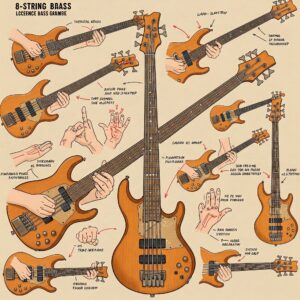
How to Play an 8 String Electric Bass
Mastering an 8 string electric bass requires adapting existing bass techniques to accommodate the instrument’s unique characteristics. Throughout my journey with extended-range basses, I’ve developed and refined approaches that help navigate the challenges these instruments present. Here’s a comprehensive guide to playing techniques specifically tailored for the 8 string electric bass.
Adapting to the Wider Neck
The most immediate challenge for most players is adjusting to the significantly wider neck of an 8 string bass:
- Hand Positioning: Position your left hand with your thumb centered on the back of the neck, allowing your fingers to arch over the fingerboard. This “classical” position provides better reach across all strings than the “baseball bat” grip often used on narrower necks.
- Economy of Movement: Develop a fretting approach that minimizes hand repositioning. Practice maintaining a fixed hand position and reaching for notes rather than shifting your entire hand for each new position.
- Finger Independence: Exercises focusing on finger independence become crucial. Practice permutation patterns (1-2-3-4, 1-2-4-3, 1-3-2-4, etc.) across the wider fingerboard to develop strength and flexibility.
- Gradual Adaptation: If transitioning from a standard bass, limit initial practice sessions to 15-20 minutes to avoid hand fatigue and potential strain. Gradually increase duration as your hand muscles develop.
According to bass educator Anthony Wellington, “The wider neck of an 8-string bass demands a fundamentally different approach to left-hand technique – imagine the difference between driving a compact car and an 18-wheeler. Both get you there, but the physical approach is completely different” (TalkBass Forum).
Right-Hand Techniques for Paired Strings
Playing paired strings effectively requires adapting your plucking hand technique:
- Fingerstyle Approach: When playing fingerstyle, you can either:
- Pluck each pair as a unit, striking both strings simultaneously with a single finger
- Play selectively, targeting either the fundamental or octave string depending on the desired sound
- Alternate between full pairs and single strings for textural variation
- Pick Techniques: When using a pick:
- Thicker picks (1.0mm+) generally provide better control across paired strings
- Angling the pick slightly helps achieve cleaner articulation
- “String skipping” techniques become more complex and require precise pick control
- Slap and Pop: These techniques take on new dimensions:
- Slapping typically engages both strings in a pair for a fuller sound
- Popping can target either string, with the higher octave string providing distinctive percussive qualities
- The wider string spacing requires adapting hand position and thumb angle
Specialized 8 String Techniques
Several techniques are particularly effective on 8 string electric bass:
- Chord Playing: The paired-string design facilitates rich chord voicings:
- Three-note chords across three courses provide full triads
- “Drop 2” and “Drop 3” voicings from guitar harmony translate well
- Inversions are more practical due to the octave strings providing higher register notes
- Harmonics: Natural and artificial harmonics gain additional complexity:
- Natural harmonics played on octave strings produce ethereal, flute-like tones
- Touch harmonics (touching the string lightly after plucking) create bell-like effects
- Harp harmonics (plucking with the right hand while the left touches harmonic nodes) become particularly effective
- Two-Handed Tapping: The extended tonal range makes tapping especially valuable:
- Right-hand tapping on higher octave strings while the left hand plays fundamentals
- Independent basslines and melodies between hands
- Chord tapping using multiple fingers of both hands
Bass virtuoso Igor Saavedra explains, “The 8-string bass isn’t simply a 4-string with more notes – it’s an instrument that encourages a pianist’s mindset, thinking in terms of independent voices and contrapuntal relationships” (Bass Musician Magazine).
Practice Strategies for 8 String Bass
Developing proficiency on 8 string electric bass benefits from structured practice:
- Isolation Exercises: Focus on specific technical challenges:
- Play scales using only the fundamental strings, then only octave strings, then combined
- Practice moving between string pairs smoothly with minimal extraneous noise
- Work on maintaining even dynamics between fundamental and octave strings
- Technical Studies: Adapt existing bass methods:
- Transpose exercises from method books like Simandl or Nanny up an octave for the higher strings
- Practice scale patterns across different string groups to develop flexibility
- Use rhythmic subdivision exercises to build coordination between paired strings
- Transcription and Application: Learn how established 8 string players approach the instrument:
- Study recordings by pioneers like Mark Egan, Igor Saavedra, and Matthew Garrison
- Transcribe piano left-hand parts as training for bass function
- Adapt guitar chord-melody arrangements to explore harmonic possibilities
Common Challenges and Solutions
Even experienced bassists encounter specific challenges when adapting to 8 string instruments:
- String Noise Management: The increased number of strings can generate unwanted noise:
- Develop muting techniques using both hands
- Practice “zoning” – keeping unused fingers in position to dampen inactive strings
- Consider using specialized foam or cloth mutes for recording situations
- Intonation Precision: Playing in tune across paired strings requires careful attention:
- Practice with a tuner to ensure consistent pressure between string pairs
- Develop awareness of how fretting force affects intonation, especially on octave strings
- Use electronic tuners that can display both strings in a pair simultaneously
- Physical Endurance: The greater physical demands require conditioning:
- Incorporate hand stretches and strength exercises into your routine
- Consider a lighter gauge string set initially while developing hand strength
- Pay attention to ergonomics and take regular breaks during practice sessions
Amplification and Signal Processing
Getting the best sound from an 8 string electric bass requires specific approaches to amplification:
- EQ Settings: Start with relatively neutral settings and adjust for your specific instrument:
- A slight midrange dip (around 500Hz) can help clarify the complex harmonics
- Gentle high-mid boost (2-3kHz) enhances the articulation of the higher strings
- Subtle compression helps even out the dynamics between string pairs
- Effects Considerations: Certain effects work particularly well with 8 string basses:
- Chorus can enhance the natural doubling effect of the paired strings
- Octave effects become redundant but sub-octave can add interesting dimensions
- Envelope filters respond differently to the complex harmonic content, often producing richer textures
Learning to play an 8 string electric bass effectively is a gradual process that rewards patience and consistent practice. As you develop facility with the instrument, you’ll discover its unique voice and how it can enhance your musical expression in ways that conventional basses cannot match.
Maintenance Tips for 8 String Electric Bass
Proper maintenance of an 8 string electric bass is essential for preserving its playability, tonal quality, and longevity. The additional strings, wider neck, and increased tension create specific maintenance requirements beyond those of traditional basses. Drawing from years of experience maintaining extended-range instruments, I’ve compiled these essential care guidelines specifically for 8 string bass owners.
String Care and Replacement
The paired-string design of most 8 string basses requires special attention to string maintenance:
- Changing Frequency: Due to the complex harmonics produced by paired strings, tone degradation may be more noticeable than on traditional basses. Consider changing strings:
- Every 1-2 months for regular performers
- Every 3-4 months for occasional players
- Immediately if visible corrosion or significant tone loss occurs
- Replacement Process: When replacing strings:
- Change one pair at a time to maintain neck tension balance
- Label old strings if saving them as emergency backups to maintain proper gauge organization
- Follow a consistent winding pattern around tuning posts for stability
- Stretch new strings thoroughly to improve tuning stability
- String Selection: Choose strings designed specifically for 8 string instruments when available:
- Balanced tension sets preserve proper neck relief
- Purpose-designed octave strings perform better than improvised substitutes
- Consider flatwound sets for reduced finger noise across multiple strings
Bass technician Dan Lakin notes, “The relationship between string tension and neck stability is exponentially more critical on 8-string instruments. Improper string replacement can literally twist a neck out of alignment over time” (Bass Gear Magazine).
Neck Adjustment and Relief
The wider neck of an 8 string bass requires vigilant monitoring of neck relief:
- Truss Rod Management: Due to increased tension:
- Check relief monthly using a straightedge or by fretting the first and last frets
- Make smaller, more gradual adjustments than you would on a 4-string (¼ turn maximum)
- Allow 24-48 hours for the neck to settle after adjustments before making further changes
- Consider seasonal humidity changes, which affect wider necks more dramatically
- Multi-Rod Systems: Some 8 string basses feature dual truss rods or carbon fiber reinforcement:
- Follow manufacturer guidelines precisely for these specialized systems
- If dual rods are present, adjust them equally unless correcting twist
- Document all adjustments in a maintenance log for future reference
- Professional Setup: Consider professional setup specifically for:
- Initial setup when acquiring a new instrument
- After significant climate changes (e.g., moving to a different region)
- When changing to significantly different string gauges
- If experiencing persistent buzzing or intonation issues
Action and Intonation Adjustment
Proper setup becomes particularly critical on extended-range instruments:
- String Height (Action): Finding the optimal balance:
- Start slightly higher than on a 4-string to accommodate greater string vibration
- Adjust incrementally, checking for buzzing across all frets
- Consider differential action (higher for lower strings, lower for higher strings)
- Test thoroughly in playing position, as neck angle changes when held
- Intonation Setting: The complex harmonic content of paired strings demands precise intonation:
- Use a high-quality strobe or polyphonic tuner for accurate reading
- Check intonation at multiple positions (open, 12th fret, 19th fret)
- Adjust each string individually, testing both the fundamental and fretted notes
- Verify octave strings separately from their fundamental partners
- Nut Maintenance: The nut is critical for proper function:
- Ensure slots are cut to proper depth and width for each string
- Apply graphite or specialized nut lubricant to prevent binding
- Consider upgrading to self-lubricating materials like Graph Tech or bone
- Watch for wear, particularly in octave string slots which experience more movement
Electronics Maintenance
The electronics in 8 string basses often control a wider frequency range and require specific attention:
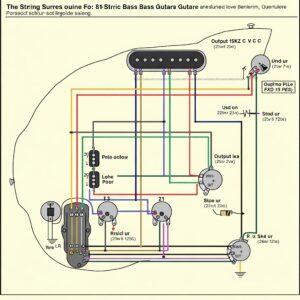
- Potentiometer Care: Volume and tone controls:
- Use contact cleaner spray annually to prevent noise
- Consider higher-quality replacement potentiometers (250k-500k) if experiencing signal degradation
- Test blend controls regularly for center detent accuracy
- Battery Management: For active systems:
- Replace batteries preventatively before important performances
- Use alkaline or lithium batteries for longer life and more consistent performance
- Remove the instrument cable when not in use to disconnect the preamp circuit
- Consider installing an LED battery indicator for at-a-glance status checks
- Pickup Height: Optimal pickup positioning:
- Set pickup height to maintain even response across all strings
- Adjust slightly further from octave strings if they dominate the output
- Follow manufacturer recommendations for specific models
- Check height after significant action adjustments
Physical Care and Storage
The physical characteristics of 8 string basses require specific handling considerations:
- Support and Handling: Due to increased neck width and often greater weight:
- Always support the neck when handling the instrument
- Use stands rated for heavier instruments
- Consider wall hangers with extended support arms designed for wider necks
- Use wider straps (3″+) with proper padding to distribute weight comfortably
- Climate Control: The larger wood mass responds differently to environmental changes:
- Maintain 45-55% relative humidity for optimal stability
- Allow longer acclimatization time when moving between temperature extremes
- Consider humidity control systems for cases in extreme environments
- Monitor for seasonal changes that may require setup adjustments
- Case Selection: Choose appropriate protection:
- Ensure cases are specifically designed for 8 string instruments
- Verify neck support accommodates the wider dimensions
- Consider flight cases for travel, as airline handling poses greater risks for extended-range instruments
- Add supplemental neck support if using cases not specifically designed for 8 string basses
Regular Maintenance Schedule
Establishing a maintenance routine helps prevent issues before they develop:
| Maintenance Task | Frequency | Notes |
|---|---|---|
| String Wiping | After each playing session | Use microfiber cloth to remove oils and residue |
| Fingerboard Cleaning | Every string change | Use specialized cleaner appropriate for board material |
| Hardware Inspection | Monthly | Check for loose screws, bridge saddles, and strap buttons |
| Truss Rod Check | Quarterly or with seasonal changes | Verify proper relief and adjust if necessary |
| Electronics Testing | Quarterly | Check all controls, inputs, and switches for proper function |
| Fret Polishing | Bi-annually | Address any rough spots or wear that affects playability |
| Professional Setup | Annually | Comprehensive evaluation by an experienced technician |
| Fretwork Inspection | Bi-annually | Check for wear, especially under octave strings |
By following these specialized maintenance guidelines, you’ll ensure your 8 string electric bass remains in optimal playing condition, sounds its best, and maintains its value over time. The additional effort required to properly maintain these complex instruments is repaid through enhanced playability, tonal consistency, and reduced need for costly repairs.
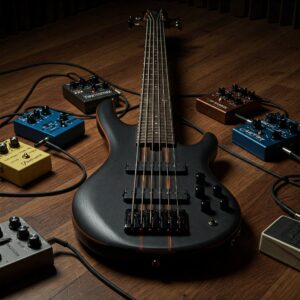
Comparison: 8 String vs Traditional 4 String Bass Guitars
Understanding the fundamental differences between 8 string electric bass guitars and their traditional 4 string counterparts helps players make informed decisions about which instrument best suits their musical needs. This comparison examines the key distinctions in design, playability, tonal characteristics, and practical applications.
Physical Design and Construction
The most obvious differences between 8 and 4 string basses appear in their physical construction:
- Neck Dimensions:
- 8 string basses feature significantly wider necks (typically 2.5-3.25 inches) compared to 4 string basses (approximately 1.5-1.75 inches)
- The additional width requires more substantial neck reinforcement, including multi-piece construction, carbon fiber rods, or dual truss rod systems
- Scale length is often extended on 8 string models (34″-35″ or longer) to maintain proper tension
- Body Construction:
- 8 string bodies are frequently designed with additional mass to balance the heavier neck
- Many 8 string designs incorporate weight-reducing features like chambering to offset the increased overall weight
- Extended upper horn designs are common to improve balance and reduce neck dive
- Hardware Requirements:
- Bridges on 8 string basses must accommodate twice as many strings in a wider configuration
- Tuning machines are typically higher-ratio designs for more precise tuning of paired strings
- Nut construction is more complex, requiring precise spacing and consistent height across eight strings
According to luthier Roger Sadowsky, “The engineering challenges of an 8-string bass increase exponentially, not linearly. It’s not simply a matter of making everything bigger – the entire instrument must be reconceptualized to handle the additional mass, tension, and vibrational characteristics” (Bass Quarterly).
Sound and Tonal Characteristics
The sonic differences between 8 and 4 string basses are substantial:
- Harmonic Content:
- 8 string basses produce naturally chorused tones with fundamental notes accompanied by octave harmonics
- The paired-string design creates a piano-like quality with greater harmonic complexity
- Sustained notes on 8 string basses exhibit a natural shimmering quality absent in traditional basses
- Frequency Response:
- While 4 string basses focus primarily on low and low-mid frequencies, 8 string models cover a broader spectrum
- The octave strings add significant content in the upper midrange and treble frequencies
- This extended range can fill sonic space typically occupied by other instruments in an ensemble
- Dynamic Response:
- 8 string basses typically display more complex dynamics due to the interaction between string pairs
- Initial attack often features greater definition due to the octave strings’ articulation
- Sustain characteristics differ, with paired strings creating sympathetic vibrations that extend note duration
In a comparative acoustic analysis published in Sound On Sound magazine, researchers found that “the harmonic spectrum of an 8-string bass contained approximately 40% more frequency content above 800Hz than its 4-string counterpart, creating a naturally ‘produced’ sound without electronic enhancement.”
Playability and Technique
The playing experience differs significantly between the two instruments:
- Learning Curve:
- 4 string basses present a gentler entry point for beginners with narrower necks and fewer strings to manage
- 8 string basses demand greater left-hand stretching ability and right-hand precision
- Developing facility on an 8 string typically requires 6-12 months of dedicated practice for players already proficient on 4 string
- Technical Approaches:
- Traditional bass techniques transfer to 8 string but require adaptation for the paired-string format
- 8 string basses enable simultaneous bassline and melodic playing not possible on 4 string
- Chord voicings and harmonics take on new dimensions due to the octave strings
- Physical Demands:
- 8 string basses generally impose greater physical requirements due to wider necks and often heavier weight
- Playing sessions on 8 string instruments typically cause faster hand fatigue until conditioning develops
- Ergonomic considerations become more critical with the larger instrument dimensions
Practical Applications and Musical Contexts
The instruments serve different musical functions:
- Genre Suitability:
- 4 string basses remain optimal for styles prioritizing simplicity and fundamental support (punk, blues, classic rock)
- 8 string basses excel in contexts emphasizing complexity and harmonic richness (jazz fusion, progressive rock, solo bass)
- Some genres (metal, funk) can benefit from either approach depending on the specific musical goals
- Ensemble Integration:
- 4 string basses typically occupy a defined frequency range that complements other instruments
- 8 string basses can overlap with keyboards, guitars, or other midrange instruments, requiring careful arrangement
- In smaller ensembles, 8 string basses can effectively fill space normally requiring multiple instruments
- Recording and Production Considerations:
- 4 string basses generally require less complex recording techniques and processing
- 8 string models benefit from microphone or DI techniques that capture their full harmonic range
- Mixing approaches differ, with 8 string basses often needing careful EQ to prevent midrange congestion
| Aspect | 4 String Bass | 8 String Bass |
|---|---|---|
| Neck Width | 1.5-1.75 inches | 2.5-3.25 inches |
| String Configuration | Single strings (E-A-D-G) | Paired strings (E/E8-A/A8-D/D8-G/G8) |
| Learning Curve | Gentle | Steep |
| Weight | 8-10 lbs typically | 10-12 lbs typically |
| Harmonic Profile | Fundamental-focused | Complex with natural chorusing |
| Genre Adaptability | Versatile across most styles | Specialized for progressive, jazz, fusion |
| Price Range | $200-$5,000+ | $800-$10,000+ |
| Amplification Needs | Standard bass amplification | Full-range systems preferred |
| Ideal Applications | Foundational support | Melodic playing, solo performance |
| Maintenance Requirements | Standard | More intensive |
💬 Just one click – help others make better buying decisions too!😊
✨ Ready to Experience Extended Range Bass? ✨
🎸 Whether you’re considering your first 8 string electric bass or looking to complement your existing 4-string collection, the instruments featured in our reviews section represent the best options available today. Click on any highlighted model to explore current pricing and discover which extended-range bass might become your next creative companion!
The choice between an 8 string and 4 string bass ultimately depends on your musical goals, physical capabilities, and stylistic preferences. Many professional bassists maintain both types in their arsenal, selecting the appropriate tool for specific musical contexts. The 8 string bass shouldn’t be viewed as an “upgrade” to a 4 string, but rather as a different instrument with its own unique characteristics and capabilities that opens alternative creative possibilities.
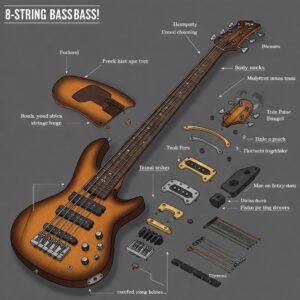
Conclusion: Is an 8 String Electric Bass Right for You?
After exploring the world of 8 string electric bass guitars in depth, the question remains: is this specialized instrument the right choice for your musical journey? The answer depends on your specific musical goals, physical capabilities, and personal preferences. Let’s synthesize what we’ve learned to help you make an informed decision.
Who Should Consider an 8 String Electric Bass
The 8 string electric bass represents an ideal choice for:
- Versatile Performers: Musicians who need to cover multiple sonic territories within a single instrument, particularly in situations with limited instrument changes
- Solo Bassists: Players who perform unaccompanied and benefit from the ability to simultaneously handle basslines, chords, and melodies
- Progressive Musicians: Those working in jazz fusion, progressive rock/metal, or experimental genres where extended-range instruments enhance creative possibilities
- Studio Musicians: Recording artists who want to add textural and harmonic complexity to their bass parts without overdubbing
- Experienced Players: Bassists who have already developed proficiency on traditional instruments and seek new creative challenges
According to bass educator and performer Steve Bailey, “The 8-string bass isn’t merely an extension of the 4-string – it’s a different instrument with its own voice, requiring a different mindset and approach. For the right player in the right context, it opens musical doors that would otherwise remain closed” (Bass Educator).
Who Might Prefer Traditional Basses
On the other hand, traditional 4, 5, or 6 string basses might better serve:
- Beginners: Those new to bass playing, who benefit from the simpler layout and gentler learning curve
- Genre Specialists: Musicians focused primarily on styles where fundamental bass function is paramount (punk, blues, traditional rock)
- Players with Physical Limitations: Those with smaller hands or physical constraints that make wider necks challenging
- Minimalists: Bassists who prefer streamlined instruments with fewer variables to manage
- Budget-Conscious Musicians: Those without the financial resources to invest in quality extended-range instruments
Finding Your Path Forward
If you’re intrigued by the 8 string electric bass but uncertain about committing fully, consider these intermediate steps:
- Try Before Buying: Visit music stores with extended-range instruments in stock, or attend bass-focused events where you can test various models
- Rent or Borrow: Some specialty shops offer rental programs that allow you to experience an 8 string bass without full financial commitment
- Start with 5 or 6: Consider 5 or 6 string basses as stepping stones to develop comfort with wider necks before tackling 8 strings
- Take Lessons: Work with an instructor experienced in extended-range instruments to develop proper technique from the beginning
- Begin with Quality: If you decide to purchase, invest in the best instrument you can afford – poorly made extended-range instruments can create unnecessary obstacles
Remember that musical instruments are tools for creative expression, and there’s no single “best” configuration that works for everyone. Many professional bassists maintain several instruments, selecting the appropriate tool for specific musical contexts. The 8 string electric bass represents one particularly specialized tool that excels in certain situations while presenting challenges in others.
What remains most important is finding the instrument that inspires you to create and express your unique musical voice. Whether that’s an 8 string electric bass with its rich harmonic complexities or a simpler instrument with focused functionality depends entirely on your personal journey as a musician.
FAQs About 8 String Electric Bass
❓ How much does a quality 8 string electric bass typically cost?
✅ Quality 8 string electric bass guitars range from $800-$5000+ depending on construction and features. Entry-level models from manufacturers like ESP and Ibanez start around $800-$1200, while mid-range options from Schecter and Warwick fall between $1500-$3000. Custom shop and boutique models from Fodera, Alembic, and MTD can exceed $8000...
❓ Are 8 string basses harder to play than 4 string basses?
✅ Yes, 8 string basses present a steeper learning curve due to wider necks and paired-string configurations. The neck width (2.5-3.25 inches vs 1.5-1.75 inches on 4-strings) requires greater left-hand stretching ability and different fretting techniques. Most players need 3-6 months to develop comfort and facility if they're already proficient on standard basses...
❓ What's the best amplifier setup for an 8 string electric bass?
✅ Full-range, bi-amped systems provide optimal amplification for 8 string electric basses. The extended frequency response needs both powerful low-end reproduction and clear high-mids for the octave strings. Professional bassists often pair a traditional bass cab (like 4×10 or 1×15 inches) with a mid/high component (like a 2×10 inches with tweeter) using separate power amps for each frequency range...
❓ Can I use regular bass strings on an 8 string electric bass?
✅ Standard bass strings can work but purpose-designed 8-string sets are strongly recommended. While you can pair regular bass strings with appropriate gauge octave strings, specialized sets from manufacturers like D'Addario, GHS, and Rotosound offer matched tension and balanced tone across all pairs. These purpose-built sets typically include properly gauged octave strings and maintain consistent tension across the instrument...
❓ What genres of music are 8 string electric basses best suited for?
✅ 8 string electric basses excel in jazz fusion, progressive rock/metal, and solo bass performance. The rich harmonic content and extended capabilities make them ideal for harmonically complex music. They're particularly valuable in smaller ensembles where bassists need to cover multiple roles simultaneously. While less common in straightforward styles like punk or traditional country, skilled players can adapt 8 string basses to virtually any genre...
Recommended for You:
- 10 Best La Bella Bass Strings for Incredible Tone and Durability in 2025
- 10 Exceptional Elixir Bass Strings for Transformative Tone Quality in 2025
- 10 Best Rotosound Bass Strings That Will Transform Your Sound in 2025
Disclaimer: This article contains affiliate links. If you purchase products through these links, we may earn a small commission at no additional cost to you.
✨ Found this helpful? Share it with your friends! 💬🤗




